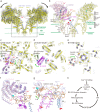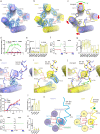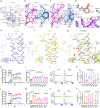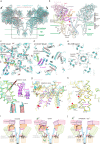Molecular basis for gating of cardiac ryanodine receptor explains the mechanisms for gain- and loss-of function mutations
- PMID: 35595836
- PMCID: PMC9123176
- DOI: 10.1038/s41467-022-30429-x
Molecular basis for gating of cardiac ryanodine receptor explains the mechanisms for gain- and loss-of function mutations
Abstract
Cardiac ryanodine receptor (RyR2) is a large Ca2+ release channel in the sarcoplasmic reticulum and indispensable for excitation-contraction coupling in the heart. RyR2 is activated by Ca2+ and RyR2 mutations are implicated in severe arrhythmogenic diseases. Yet, the structural basis underlying channel opening and how mutations affect the channel remains unknown. Here, we address the gating mechanism of RyR2 by combining high-resolution structures determined by cryo-electron microscopy with quantitative functional analysis of channels carrying various mutations in specific residues. We demonstrated two fundamental mechanisms for channel gating: interactions close to the channel pore stabilize the channel to prevent hyperactivity and a series of interactions in the surrounding regions is necessary for channel opening upon Ca2+ binding. Mutations at the residues involved in the former and the latter mechanisms cause gain-of-function and loss-of-function, respectively. Our results reveal gating mechanisms of the RyR2 channel and alterations by pathogenic mutations at the atomic level.
© 2022. The Author(s).
Conflict of interest statement
The authors declare no competing interests.
Figures






Similar articles
-
Arrhythmogenesis in a catecholaminergic polymorphic ventricular tachycardia mutation that depresses ryanodine receptor function.Proc Natl Acad Sci U S A. 2015 Mar 31;112(13):E1669-77. doi: 10.1073/pnas.1419795112. Epub 2015 Mar 16. Proc Natl Acad Sci U S A. 2015. PMID: 25775566 Free PMC article.
-
Regulatory mechanisms of ryanodine receptor/Ca2+ release channel revealed by recent advancements in structural studies.J Muscle Res Cell Motil. 2021 Jun;42(2):291-304. doi: 10.1007/s10974-020-09575-6. Epub 2020 Feb 10. J Muscle Res Cell Motil. 2021. PMID: 32040690 Free PMC article. Review.
-
Investigations of the contribution of a putative glycine hinge to ryanodine receptor channel gating.J Biol Chem. 2013 Jun 7;288(23):16671-16679. doi: 10.1074/jbc.M113.465310. Epub 2013 Apr 30. J Biol Chem. 2013. PMID: 23632022 Free PMC article.
-
A mechanistic description of gating of the human cardiac ryanodine receptor in a regulated minimal environment.J Gen Physiol. 2012 Aug;140(2):139-58. doi: 10.1085/jgp.201110706. Epub 2012 Jul 16. J Gen Physiol. 2012. PMID: 22802361 Free PMC article.
-
Functional Impact of Ryanodine Receptor Oxidation on Intracellular Calcium Regulation in the Heart.Rev Physiol Biochem Pharmacol. 2016;171:39-62. doi: 10.1007/112_2016_2. Rev Physiol Biochem Pharmacol. 2016. PMID: 27251471 Free PMC article. Review.
Cited by
-
Structure-based mechanism of RyR channel operation by calcium and magnesium ions.PLoS Comput Biol. 2025 Apr 29;21(4):e1012950. doi: 10.1371/journal.pcbi.1012950. eCollection 2025 Apr. PLoS Comput Biol. 2025. PMID: 40300027 Free PMC article.
-
The Role of Ryanodine Receptor 2 Polymorphisms in Oral Squamous Cell Carcinoma Susceptibility and Clinicopathological Features.Int J Mol Sci. 2024 Sep 25;25(19):10328. doi: 10.3390/ijms251910328. Int J Mol Sci. 2024. PMID: 39408657 Free PMC article.
-
Dual role of the S5 segment in type 1 ryanodine receptor channel gating.Commun Biol. 2024 Sep 18;7(1):1108. doi: 10.1038/s42003-024-06787-1. Commun Biol. 2024. PMID: 39294299 Free PMC article.
-
Ligand sensitivity of type-1 inositol 1,4,5-trisphosphate receptor is enhanced by the D2594K mutation.Pflugers Arch. 2023 May;475(5):569-581. doi: 10.1007/s00424-023-02796-x. Epub 2023 Mar 7. Pflugers Arch. 2023. PMID: 36881190 Free PMC article.
-
Propagation of conformational instability in FK506-binding protein FKBP12.Biochim Biophys Acta Proteins Proteom. 2024 May 1;1872(3):140990. doi: 10.1016/j.bbapap.2023.140990. Epub 2023 Dec 23. Biochim Biophys Acta Proteins Proteom. 2024. PMID: 38142946 Free PMC article.
References
Publication types
MeSH terms
Substances
LinkOut - more resources
Full Text Sources
Research Materials
Miscellaneous

